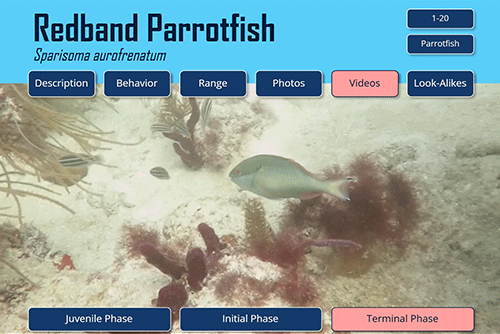Fish Identification Training
 Explore this project
Explore this projectUniversity level Marine Science students and staff
Graduates were struggling to identify marine species when starting jobs and internships, and employers complained of spending extra time training them. Employers therefore became less willing to hire our graduates.
I helped design and teach a new species ID course for the university. There were no existing materials, so I built the entire course from scratch. Beyond the storyline file, the course included in-person lessons, practice quizzes, weekly graded quizzes, two field trip exercises, and two exams.
Only a sample of the Fish ID section is shown here, but the course also covered corals, sponges, algae, sharks, and other key marine organisms employers were looking for. Much of the content is based on my own expertise, supported by expert sources. About half of the photos and videos are mine, collected while diving.
I followed the ADDIE model for this course. Despite spending dedicated time to analyze the needs and come up with the design, the bulk of the time on the project was spent developing in Storyline.
Graduates being placed in internships and jobs were not meeting expectations of their employers and could only identify about 20% of underwater organisms down to the species level. The goal was to have them quickly and positively identify at least 80% of the 100 most common fish, 30 most common corals, and 35 additional miscellaneous species (algae, seagrass, invertebrates, sharks, dolphins, conchs, etc).
Most ID classes teach species by type (learn angelfish, then butterflyfish, then cardinalfish, etc.). However, this method is not scaffold the most common fish. By using data from hundreds of thousands of dives to confidently establish the list of most commonly seen species, the first week focuses on the 20 most common fish, then the second week adds the next 20, and so on. In this way, learners studied and recalled the fish that they're most likely to see.


After establishing the curriculum, I developed a course in Storyline with functionality akin to an app. All other ID training resources I've seen include photos and descriptions, but hardly any have videos (particularly of each life phase), and none have any form of comparison to compare/contrast species that are commonly mistaken. This course was particularly challenging because I originally built it in 2013 using a laptop, and the Storyline file had over 400 slides, each one with multiple layers and triggers to other slides.
The course was released to learners through the university LMS, and each one would learn the species prior to coming to class, where they would be quizzed. The quizzes were followed by a review of that week's species, with some personal stories, discussion, and tips for remembering each species. Two field trips were taken to a large aquarium next to the university where I showed students the species in real life as we looked in each of their many tanks.
The initial feedback was anecdotal; employers felt graduates weren’t prepared to identify fish species in the field. In response, we partnered with them to set a clear goal: 80% identification accuracy upon hiring.
Before the course, students averaged around 20%. After completing it, class averages were about 90%. I incorporated feedback from students and faculty to improve version 1, adding various elements and quizzes. The most significant outcome was the shift in employer perception. Once interns and new hires arrived better prepared, the feedback was overwhelmingly positive.

Species identification is a very visual skill, and it relies on real-world visuals. Photos are great for pointing out certain identifying features, so I not only included photos, but added an interactive way to display/hide the identifying features. Furthermore, pictures don't show how certain species really look in the real world, so I added videos.
When identifying species that change their appearance throughout their life cycle, it's often the in-between phases that are the most challenging to identify. Therefore, I deliberately included photos and videos that showed marine organisms in life phases that were potentially challenging to identify to best mimic what researchers would see in the real world.
Most ID training I've seen is linear; it's just words and photos from start to finish, organized alphabetically by fish family or body type. I made this course interactive, with navigation that lets learners jump around and quickly find what they need.
Content can be sorted by either body type or by popularity. In the “Look-Alikes” section, images link to similar species, making it easy to compare commonly confused organisms. It took a lot of time to set up all those links and triggers, but it’s one of the features that sets this course apart from all other ID training programs.